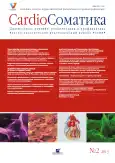Objective: to study the dose-dependent effect of rosuvastatin on blood lipids and lipoproteins (LP), endothelial functional activity, coagulation, and safety parameters in patients with hyperlipidemia (HLP) and hypertension after cerebral ischemic stroke (CIS). Subjects and method. The trial included 34 patients (mean age 59,4±7,4 years) with types IIa or IIb HLP and CIS-complicated hypertension. The patients were randomized to 2 groups: 1) rosuvastatin 10 mg and 2) rosuvastatin 20 mg. The trial lasted 12 weeks. The dose of rosuvastatin remained unchanged throughout the trial. The authors evaluated the impact of therapy on the blood concentration of lipids, LP, fibrinogen, end products of nitric oxide (NO) metabolism, and endothelin-1 (ET-1), cerebral blood flow by great cerebral artery Doppler ultrasound data, as well as the parameters reflecting the safety of the therapy. Results. After 12-week therapy with rosuvastatin 10 and 20 mg, there was a significant decrease in the level of cholesterol by 30 and 35%, low-density lipoprotein (LDL) cholesterol by 40 and 45%, and triglycerides by 18 and 26%, respectively. Increasing the dose of rosuvastatin was attended by a significant rise (by 18%) in the number of patients with target LDL cholesterol levels. Rosuvastatin therapy caused no changes in the high baseline level of fibrinogen. At the same time, at the rosuvastatin doses of 10 and 20 mg, the concentrations of end products of NO metabolism increased by 14,3 and 12,4%, respectively. The vasoprotective effect of rosuvastatin 20 mg showed itself just at therapy week 6. Significantly decreased ET-1 levels were found when rosuvastatin was given in a dose of 10 mg; this was directly related to the baseline concentration of ET-1. In the patients who had an ET-1 level of >0,51 fmol/ml, its drop was 22,5% (p<0,05). Some improvement of cerebral blood flow velocities in the internal carotid artery and in the V2/V3-segments of the vertebral artery might be expected in post-CIS patients taking the average dose (20 mg) of rosuvastatin. It should be remarked that the test doses of rosuvastatin are well tolerated and cause no adverse reactions. Conclusion. The antiatherogenic and pleiotropic effects of the two rosuvastatin doses 10 and 20 mg were shown in the post-CIS patients with HLP and hypertension. The pleiotropic activity of rosuvastatin, such as an increase in NO bioavailability and a reduction in ET-1 concentrations, was manifested when both the starting (10 mg) and average (20 mg) doses of rozuvastatin were used. At the same time, rosuvastatin showed dose-depended effects in lowering LDL cholesterol levels, enhancing NO bioavailability, and improving cerebral blood flow velocities.
 5-11
5-11


 11-15
11-15


 15-19
15-19


 20-26
20-26


 27-36
27-36


 37-42
37-42


 43-47
43-47


 47-52
47-52


 52-57
52-57


 57-66
57-66


 67-71
67-71


 72-80
72-80


 81-91
81-91


 91-93
91-93


 94
94











